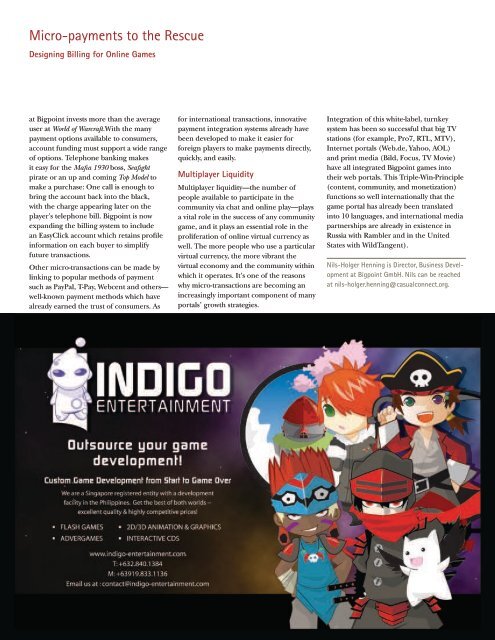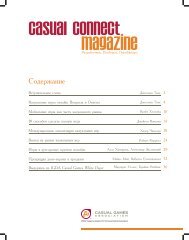Download .pdf - magazine & cover archive - Casual Connect
Download .pdf - magazine & cover archive - Casual Connect
Download .pdf - magazine & cover archive - Casual Connect
Create successful ePaper yourself
Turn your PDF publications into a flip-book with our unique Google optimized e-Paper software.
Micro-payments to the Rescue<br />
Designing Billing for Online Games<br />
at Bigpoint invests more than the average<br />
user at World of Warcraft.With the many<br />
payment options available to consumers,<br />
account funding must support a wide range<br />
of options. Telephone banking makes<br />
it easy for the Mafia 1930 boss, Seafight<br />
pirate or an up and coming Top Model to<br />
make a purchase: One call is enough to<br />
bring the account back into the black,<br />
with the charge appearing later on the<br />
player’s telephone bill. Bigpoint is now<br />
expanding the billing system to include<br />
an EasyClick account which retains profile<br />
information on each buyer to simplify<br />
future transactions.<br />
Other micro-transactions can be made by<br />
linking to popular methods of payment<br />
such as PayPal, T-Pay, Webcent and others—<br />
well-known payment methods which have<br />
already earned the trust of consumers. As<br />
for international transactions, innovative<br />
payment integration systems already have<br />
been developed to make it easier for<br />
foreign players to make payments directly,<br />
quickly, and easily.<br />
Multiplayer Liquidity<br />
Multiplayer liquidity—the number of<br />
people available to participate in the<br />
community via chat and online play—plays<br />
a vital role in the success of any community<br />
game, and it plays an essential role in the<br />
proliferation of online virtual currency as<br />
well. The more people who use a particular<br />
virtual currency, the more vibrant the<br />
virtual economy and the community within<br />
which it operates. It’s one of the reasons<br />
why micro-transactions are becoming an<br />
increasingly important component of many<br />
portals’ growth strategies.<br />
Integration of this white-label, turnkey<br />
system has been so successful that big TV<br />
stations (for example, Pro7, RTL, MTV),<br />
Internet portals (Web.de, Yahoo, AOL)<br />
and print media (Bild, Focus, TV Movie)<br />
have all integrated Bigpoint games into<br />
their web portals. This Triple-Win-Principle<br />
(content, community, and monetization)<br />
functions so well internationally that the<br />
game portal has already been translated<br />
into 10 languages, and international media<br />
partnerships are already in existence in<br />
Russia with Rambler and in the United<br />
States with WildTangent).<br />
Nils-Holger Henning is Director, Business Development<br />
at Bigpoint GmbH. Nils can be reached<br />
at nils-holger.henning@casualconnect.org.<br />
Making Money Off of Free Games<br />
Using Micro-transactions to Monetize Free MMOs in Russia<br />
In recent years the terms “microtransaction<br />
system” and “micro-payments”<br />
have been floating around a lot all around<br />
the world. The success of such systems on<br />
the Asian game market and the possibility<br />
of their implementation in games in<br />
Europe and North America have been<br />
wildly discussed by many involved in the<br />
game industry.<br />
So what does a micro-transaction system<br />
actually mean and why has it proven to be<br />
so successful in both Russia and some Asian<br />
countries? Basically, a micro-transaction<br />
system is a business model used for freeto-play<br />
online games that allows players<br />
to purchase different in-game items at a<br />
very low price. Since the items are cheap<br />
the payments for them are small, people<br />
aptly began to call these transactions<br />
“micro-transactions.” To understand the<br />
reasons why this model has proven to be<br />
so successful we will have to take a look at<br />
what a free-to-play game really means.<br />
How has the micro-transaction<br />
system been implemented in<br />
“free-to-play” games in Russia?<br />
It’s obvious from their name that you pay<br />
nothing to play a free-to-play game. But<br />
if you want, you can purchase in-game<br />
currency and a great variety of extra ingame<br />
items and abilities for a very low<br />
price, thus allowing your character to<br />
progress faster in the game and/or look<br />
different from all the other characters who<br />
play for free.<br />
Since the free-to-play game model has been<br />
very successful in Korea it is often referred<br />
to as the “Korean Model.” However, in<br />
Russia we call it the “Russian Model”<br />
because competing models, including<br />
subscription and trial-to-purchase, maintain<br />
insignificant market share in comparison to<br />
free-to-play in Russia’s online game market.<br />
In fact, approximately 93% of all Russian<br />
massively multiplayer online games use the<br />
free-to-play model.<br />
In 2007, the size of Russia’s free-to-play<br />
game market was estimated at $70 million<br />
USD and the number of Internet users in<br />
Russia exceeded 27 million people, fiveto-six<br />
million of whom play online games. 1<br />
About 10%–30% of the users who play freeto-play<br />
games two times per month or more<br />
make in-game purchases. 2<br />
In 2007, IT Territory earned over $20<br />
million (USD) using the micro-transaction<br />
system which has been successfully<br />
implemented in all its free-to-play online<br />
games (www.dwar.ru, www.territory.ru,<br />
3k.mail.ru, drive.mail.ru etc.).<br />
What’s so special about free-to-play<br />
games that make players pay when<br />
they could just play for free?<br />
Players who engage in subscription-based<br />
games have to pay before they start playing.<br />
This causes many players to feel as though<br />
they have already paid “enough” for the<br />
experience. The goal of the developers of<br />
subscription-based games is to create a level<br />
playing field so that the players feel the<br />
game is fair to everyone. If the developers<br />
were to offer in-game items for sale it would<br />
break the balance of the game allowing<br />
those who spend more to crush the normal<br />
subscribers, causing the normal subscribers<br />
to feel cheated and alienated by the<br />
inequality in game-play.<br />
Shares of Different MMO Game Models<br />
on Russia’s Game Market<br />
Free to Play 93%<br />
Trial-to-Purchase,<br />
Subscription 7%<br />
Business Models<br />
Alisa Chumachenko<br />
“<br />
”<br />
Would you pay $1 USD<br />
for this magic crystal?<br />
No? Well right<br />
now a few million<br />
players worldwide<br />
are doing just that!<br />
In free-to-play games, players do not<br />
need to put money down before playing.<br />
After they become involved enough in<br />
the game, players will desire to perform<br />
better, to edge out the competition, and<br />
to give themselves a unique appearance to<br />
stand out from the others. Thus motivated,<br />
players will begin to make purchases of<br />
game items because of their low cost and<br />
the fact that they won’t feel as if they have<br />
“already paid” as in the subscription-based<br />
model. Although it is possible to “earn”<br />
most items without purchasing them, it is<br />
time-consuming—and most players will be<br />
willing to pay the minimal costs to save time.<br />
Lets’ take a look at what you can sell to<br />
players in a free-to-play game:<br />
• Game Currency is the first thing players<br />
buy in the game—because without game<br />
money they can’t purchase any in-game<br />
items. Due to the structure of the game,<br />
players will eventually need to fill their<br />
character’s pockets with game currency<br />
in order to progress.<br />
• Power-ups and Limited-Use Items are<br />
the second most popular category of<br />
game items that players buy in the game.<br />
These are finite enhancements and<br />
items that can be used only once or a<br />
few times until they run out and must be<br />
purchased again. These include things<br />
like special potions and magic scrolls that<br />
can have devastating effects. Though they<br />
1 2 Entermedia Statistic Researches IT Territory Statistic Researches<br />
0 <strong>Casual</strong> <strong>Connect</strong> Magazine <strong>Casual</strong> <strong>Connect</strong> Magazine 1



